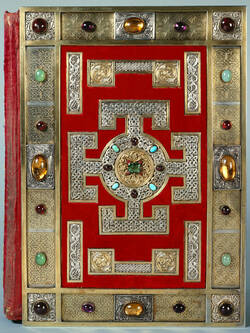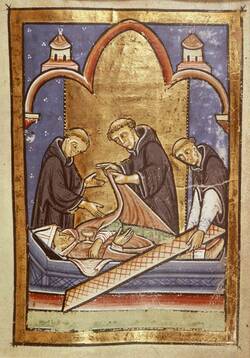From the Medieval Research Blog: "By the Bones of Saint Cuthbert: Books, Embroidery, and Bodily Incorruption"

When the Vikings invaded the northeastern coast of Britain in 793, they raided the monastery at Lindisfarne. The monks fled – and they carried with them the remains of Saint Cuthbert.
His coffin not only contained a corpse but also material relics, the Saint Cuthbert Gospel among them. The book so well preserved in his coffin has been recognized as a marvel among medieval manuscripts, along with the Lindisfarne Gospels, which the monks also saved from destruction by the Danes. Much like these extraordinary books, the embroidery that survived alongside Saint Cuthbert’s body is remarkable for its rarity.
Cuthbert of Lindisfarne was born in 634 and spent his life as a monk, bishop, and hermit in the Kingdom of Northumbria. When he died in 687, he was buried at Lindisfarne. As the Venerable Bede recounts the story, Saint Cuthbert’s coffin was opened again 11 years later with the intention of removing his bones to a reliquary, but his body was found to be perfectly preserved.

Under the duress of Danish attack, it was more than 100 years before the monks laid Saint Cuthbert to rest in Durham, where they settled in 995. Several artifacts accompanied Saint Cuthbert as he traveled posthumously around the English countryside, and the book and embroidery are very special for their survival.
The Saint Cuthbert Gospel was discovered when the coffin was opened at Durham Cathedral in 1104, and like the body of its patron, the book remained incredibly well preserved. Dated to the early 8th century, it is the earliest European book to retain an original, intact binding. The covers are made from goatskin that has been dyed red and decorated; the tooled leather is stretched over wooden boards, most likely birch. It is a pocket-sized book measuring 5.4 by 3.6 inches, and the manuscript contains the Gospel of Saint John.
This is an excerpt from "By the Bones of Saint Cuthbert: Books, Embroidery, and Bodily Incorruption" by Dr. Emily McLemore (Teaching Scholar, Department of English, University of Notre Dame). Read the Full Story.